Analysis of the Dynamic Properties of a Discrete Epidemic Model Affected by Media Coverage
Abstract
1. Introduction
2. Establishment of the System and the Points of Equilibrium
- (1).
- and if and only if , , then the fixed point E is called a sink when the fixed point E is asymptotically stable;
- (2).
- and , or and if and only if , then the fixed point E is called the saddle point;
- (3).
- and if and only if , , then the fixed point E is called the source, and at this time the fixed point E is unstable;
- (4).
- and are a pair of conjugate complex roots if and only if and .
- (1).
- If then and , is a sink;
- (2).
- If or then and , or and , is a saddle point;
- (3).
- If then and , is a source.
- (1).
- If then and , is a sink;
- (2).
- If then and , or and , is a saddle point;
- (3).
- If then and , is a source;
- (4).
- If and are a pair of conjugate complex roots.
3. Bifurcation Analysis of Equilibrium Points
3.1. Flip Bifurcation
3.2. Neimark–Sacker Bifurcation
4. Chaos Control
4.1. State Feedback Control
4.2. Hybrid Control Method
5. Numerical Simulation
6. Conclusions
Author Contributions
Funding
Institutional Review Board Statement
Informed Consent Statement
Data Availability Statement
Conflicts of Interest
References
- Gumel, A.B.; Ruan, S.; Day, T.; Watmough, J.; Brauer, F.; Van den, P.; Gabrielson, D.; Bowman, C.; Alexander, M.E.; Ardal, S.; et al. Modelling strategies for controlling SARS outbreaks. Proc. R. Soc. Lond. B 2004, 271, 2223–2232. [Google Scholar] [CrossRef] [PubMed]
- Premkumar, M.; Devurgowda, D.; Dudha, S.; Maiwall, R.; Bihari, C.; Grover, S.; Gupta, E.; Kumar, S.; Sarin, S.K. A/H1N1/09 Influenza is Associated With High Mortality in Liver Cirrhosis. Clin. Exp. Hepatol. 2019, 9, 162–170. [Google Scholar] [CrossRef]
- Yıldırım, M.; Solmaz, F. COVID-19 burnout, COVID-19 stress and resilience: Initial psychometric properties of COVID-19 Burnout Scale. Death Stud 2020, 46, 524–532. [Google Scholar] [CrossRef] [PubMed]
- Deng, J.; Tang, S.; Shu, H. Joint impacts of media, vaccination and treatment on an epidemic Filippov model with application to COVID-19. J. Theor. Biol. 2021, 523, 110698. [Google Scholar] [CrossRef]
- Miller, E. Rapid evaluation of the safety of COVID-19 vaccines: How well have we done? Clin. Microbiol. Infect. 2022, 28, 477–478. [Google Scholar] [CrossRef]
- Shoaib, M.; Kainat, S.; Alabduljabbar, A.A.; Nisar, K.S.; Zahoor Raja, M.A. Integrated intelligent neuro-evolutionary computing approach to study SEIRC model representing campylobacteriosis transmission dynamics. Appl. Math. Sci. Eng. 2024, 33, 2441257. [Google Scholar] [CrossRef]
- Waqar, M.; Khan, Z.A.; Khawaja, S.T.; Chaudhary, N.I.; Khan, S.; Cheema, K.M.; Khan, M.F.; Ahmed, S.S.; Raja, M.A.Z. Explainable clinical diagnosis through unexploited yet optimized fine-tuned ConvNeXt models for accurate monkeypox disease classification. SLAS Technol. 2025, 33, 100336. [Google Scholar] [CrossRef] [PubMed]
- Phua, K.L.; Lee, L. Meeting the Challenge of Epidemic Infectious Disease Outbreaks: An Agenda for Research. J. Public Health Pol. 2005, 26, 122–132. [Google Scholar] [CrossRef]
- Mustafa, N.; Rahman, J.U.; Omame, A. Modelling of Marburg virus transmission dynamics: A deep learning-driven approach with the effect of quarantine and health awareness interventions. Model. Earth Syst. Environ. 2024, 10, 7337–7357. [Google Scholar] [CrossRef]
- Mannan, A.; Shoket, N.; Ul Rahman, J.; Uwitije, R. Dynamic analysis of ebola virus disease with non-linear incidence rate using morlet wavelet neural networks and hybrid optimization techniques. Model. Earth Syst. Environ. 2025, 11, 79. [Google Scholar] [CrossRef]
- Misra, A.K.; Sharma, A.; Shukla, J.B. Modeling and analysis of effects of awareness programs by media on the spread of infectious diseases. Math. Comput. Model. 2011, 53, 1221–1228. [Google Scholar] [CrossRef]
- Tchuenche, J.M.; Dube, N.; Bhunu, C.P.; Smith, R.J.; Bauch, C.T. The impact of media coverage on the transmission dynamics of human influenza. BMC Public Health 2011, 11, S5. [Google Scholar] [CrossRef]
- Sahu, G.P.; Dhar, J. Dynamics of an SEQIHRS epidemic model with media coverage, quarantine and isolation in a community with pre-existing immunity. J. Math. Anal. Appl. 2015, 421, 1651–1672. [Google Scholar] [CrossRef]
- Yan, Q.; Tang, S.; Gabriele, S.; Wu, J. Media coverage and hospital notifications: Correlation analysis and optimal media impact duration to manage a pandemic. J. Theor. Biol. 2016, 390, 1–13. [Google Scholar] [CrossRef]
- Zhou, W.; Xiao, Y.; Heffernan, J.M. Optimal media reporting intensity on mitigating spread of an emerging infectious disease. PLo1S ONE 2019, 14, e0213898. [Google Scholar] [CrossRef]
- Bitrus, K.; Abdullah, F.A.; Adewole, M.O. Uncovering the influence of public awareness on dengue population dynamics: A mathematical model approach. Bol. Soc. Mat. Mex. 2025, 31, 86. [Google Scholar] [CrossRef]
- Sun, Z.; Zhang, H.; Yang, Y.; Wan, H.; Wang, Y. Impacts of geographic factors and population density on the COVID-19 spreading under the lockdown policies of China. Sci. Total Environ. 2020, 746, 141347. [Google Scholar] [CrossRef]
- Kahn, R.; Holmdahl, I.; Reddy, S.; Jernigan, J.; Mina, M.J.; Slayto, R.B. Mathematical Modeling to Inform Vaccination Strategies and Testing Approaches for Coronavirus Disease 2019 (COVID-19) in Nursing Homes. Clin. Microbiol. Infect. 2022, 74, 597–603. [Google Scholar] [CrossRef] [PubMed]
- Das, D.K.; Khajanchi, S.; Kar, T.K. The impact of the media awareness and optimal strategy on the prevalence of tuberculosis. Appl. Math. Comput. 2020, 366, 124732. [Google Scholar] [CrossRef]
- Liu, P.; Luo, Y.; Teng, Z. Role of media coverage in a SVEIR-I epidemic model with nonlinear incidence and spatial heterogeneous environment. Math. Biosci. Eng. 2023, 20, 15641–15671. [Google Scholar] [CrossRef] [PubMed]
- Liu, J.; Peng, B.; Zhang, T. Effect of discretization on dynamical behavior of SEIR and SIR models with nonlinear incidence. Appl. Math. Lett. 2015, 39, 60–66. [Google Scholar] [CrossRef]
- Qin, W.; Zhang, J.; Dong, Z. Media impact research: A discrete SIR epidemic model with threshold switching and nonlinear infection forces. Math. Biosci. Eng. 2023, 20, 17783–17802. [Google Scholar] [CrossRef]
- Zhu, L.; Wang, X.; Zhang, H.; Shen, S.; Li, Y.; Zhou, Y. Dynamics analysis and optimal control strategy for a SIRS epidemic model with two discrete time delays. Phys. Scr. 2020, 95, 035213. [Google Scholar] [CrossRef]
- Zhang, T.; Liu, J.; Teng, Z. Threshold conditions for a discrete nonautonomous SIRS model. Math. Methods Appl. Sci. 2015, 38, 1781–1794. [Google Scholar] [CrossRef]
- van den Driessche, P.; Yakubu, A.A. Disease Extinction Versus Persistence in Discrete-Time Epidemic Models. Bull. Math. Biol. 2019, 81, 4412–4446. [Google Scholar] [CrossRef] [PubMed]
- Cao, H.; Zhou, Y.; Ma, Z. Bifurcation analysis of a discrete SIS model with bilinear incidence depending on new infection. Math. Biosci. Eng. 2013, 10, 1399–1417. [Google Scholar] [CrossRef] [PubMed]
- Peng, M. Bifurcation and chaotic behavior in the Euler method for a Uçar prototype delay model. Chaos Solitons Fractals 2004, 22, 483–493. [Google Scholar] [CrossRef]
- Anguelov, R.; Dukuza, K.; Lubuma, J.M.S. Backward bifurcation analysis for two continuous and discrete epidemiological models. Math. Methods Appl. Sci. 2018, 41, 8784–8798. [Google Scholar] [CrossRef]
- Yu, X.; Liu, M.; Zheng, Z.; Hu, D. Complex dynamics of a discrete-time SIR model with nonlinear incidence and recovery rates. Int. J. Biomath. 2023, 16, 2250131. [Google Scholar] [CrossRef]
- Arenas, A.; Garijo, A.; Gómez, S.; Villadelprat, J. Bifurcation analysis of the Microscopic Markov Chain Approach to contact-based epidemic spreading in networks. Chaos Solitons Fractals 2023, 166, 112921. [Google Scholar] [CrossRef]
- Zhang, X.; Zhang, C.; Zhang, Y. Pattern dynamics analysis of a time-space discrete FitzHugh-Nagumo (FHN) model based on coupled map lattices. Comput. Math. Appl. 2024, 157, 92–123. [Google Scholar] [CrossRef]
- Wu, G.C.; Baleanu, D. Discrete chaos in fractional delayed logistic maps. Nonlinear Dyn. 2015, 80, 1697–1703. [Google Scholar] [CrossRef]
- Li, Y.; Rafaqat, M.; Zia, T.J.; Ahmed, I.; Jung, C.Y. Flip and Neimark-Sacker Bifurcations of a Discrete Time Predator-Prey Model. IEEE Access 2019, 7, 123430–123435. [Google Scholar] [CrossRef]
- Chen, X.; Yuan, S.; Jing, Z.; Fu, X. Bifurcation and Chaos of a Discrete-Time Mathematical Model for Tissue Inflammation. J. Dyn. Diff. Equat. 2016, 28, 281–299. [Google Scholar] [CrossRef]
- Singh, A.; Deolia, P. Bifurcation and Chaos in a Discrete Predator–Prey Model with Holling Type-III functional Response and harvesting Effect. J. Biol. Syst. 2021, 29, 451–478. [Google Scholar] [CrossRef]
- Chakraborty, K. Ecological complexity and feedback control in a prey–predator system with Holling type III functional response. COMPLEXITY 2016, 21, 346–360. [Google Scholar] [CrossRef]
- Auerbach, D.; Grebogi, C.; Ott, E.; Yorke, J.A. Controlling chaos in high dimensional systems. Phys. Rev. Lett. 1992, 69, 3479–3482. [Google Scholar] [CrossRef]
- Luo, X.S.; Chen, G.; Wang, B.H.; Fang, J.Q. Hybrid control of period-doubling bifurcation and chaos in discrete nonlinear dynamical systems. Chaos Solitons Fractals 2003, 18, 775–783. [Google Scholar] [CrossRef]
- Elaydi, S.N. Discrete Chaos; Chapman & Hall/CRC: Boca Raton, FL, USA, 2007. [Google Scholar]
- Din, Q. Complexity and chaos control in a discrete-time prey-predator model. Commun. Nonlinear Sci. Numer. Simul. 2017, 49, 113–134. [Google Scholar] [CrossRef]
- Yuan, L.G.; Yang, Q.G. Bifurcation, invariant curve and hybrid control in a discrete-time predator–prey system. Appl. Math. Model. 2015, 39, 2345–2362. [Google Scholar] [CrossRef]
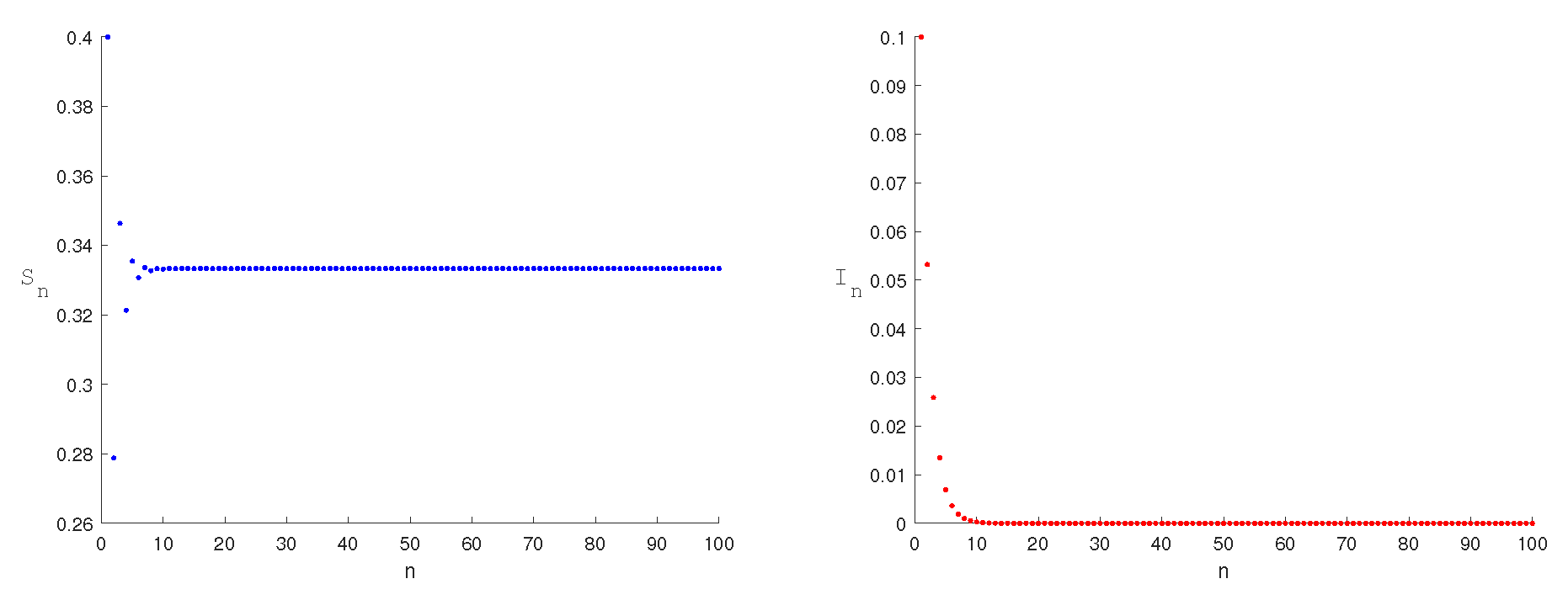


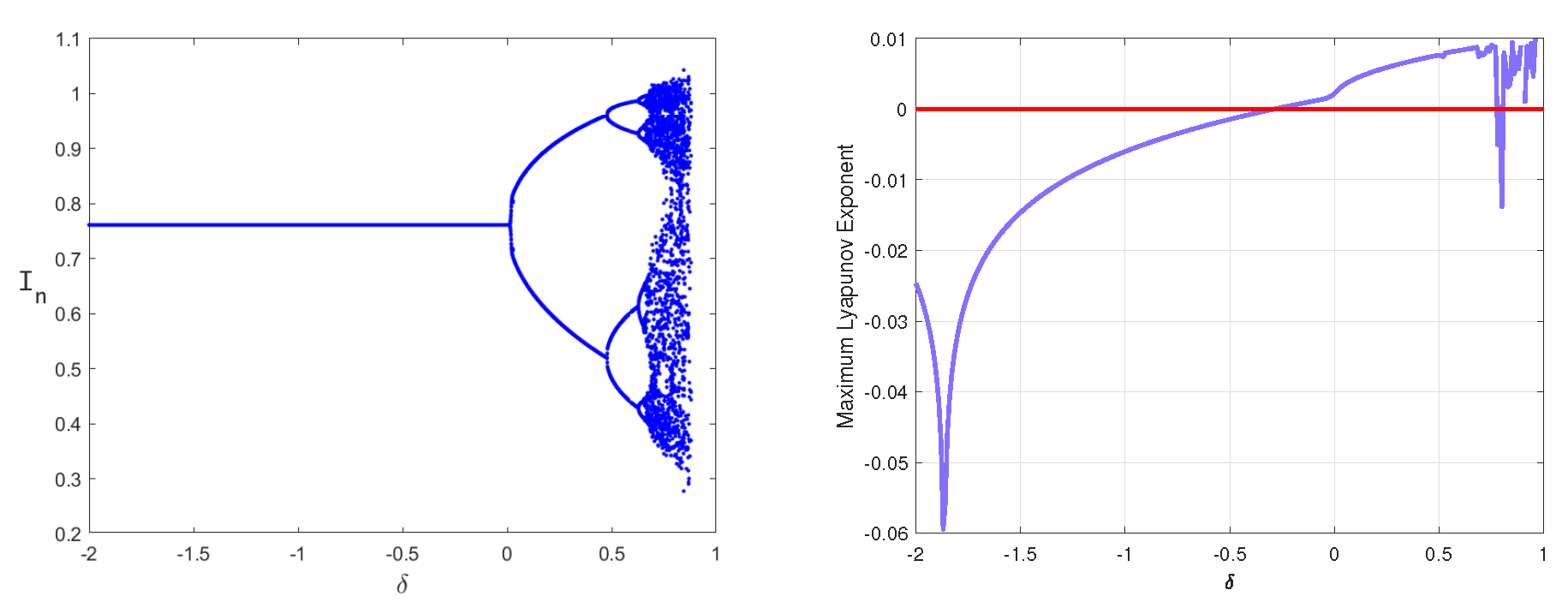
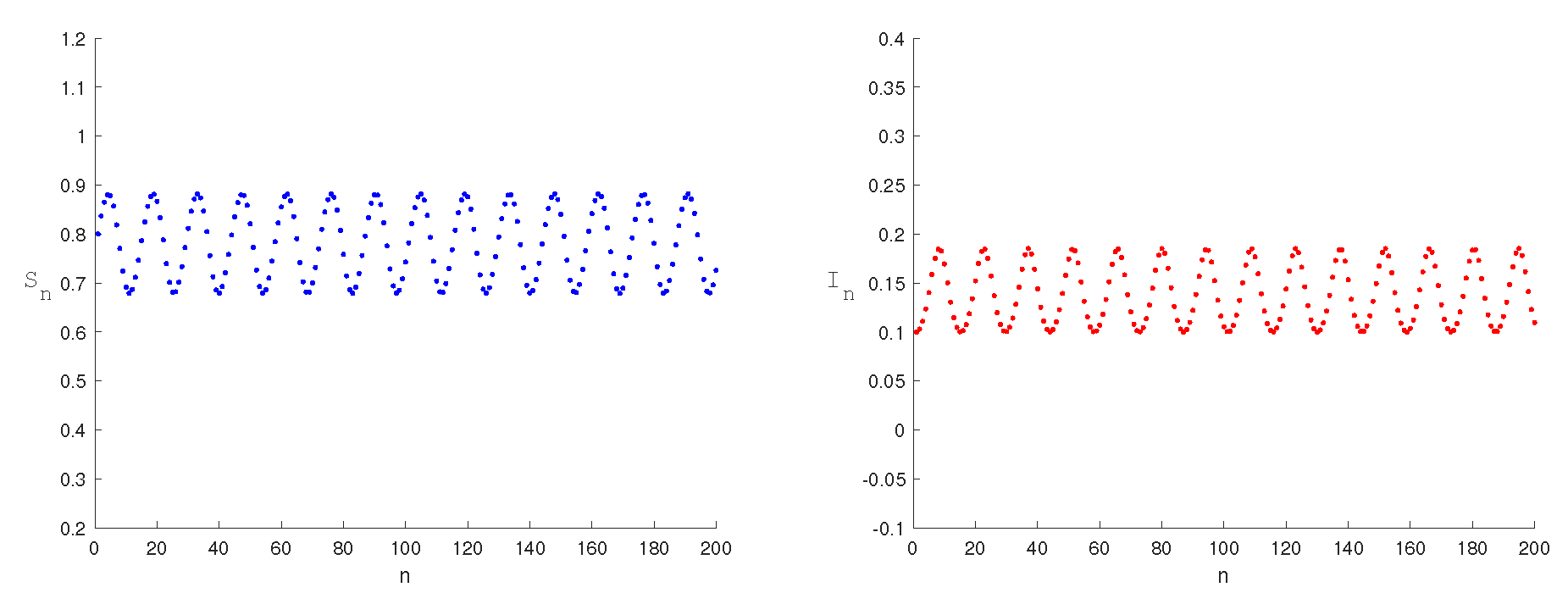
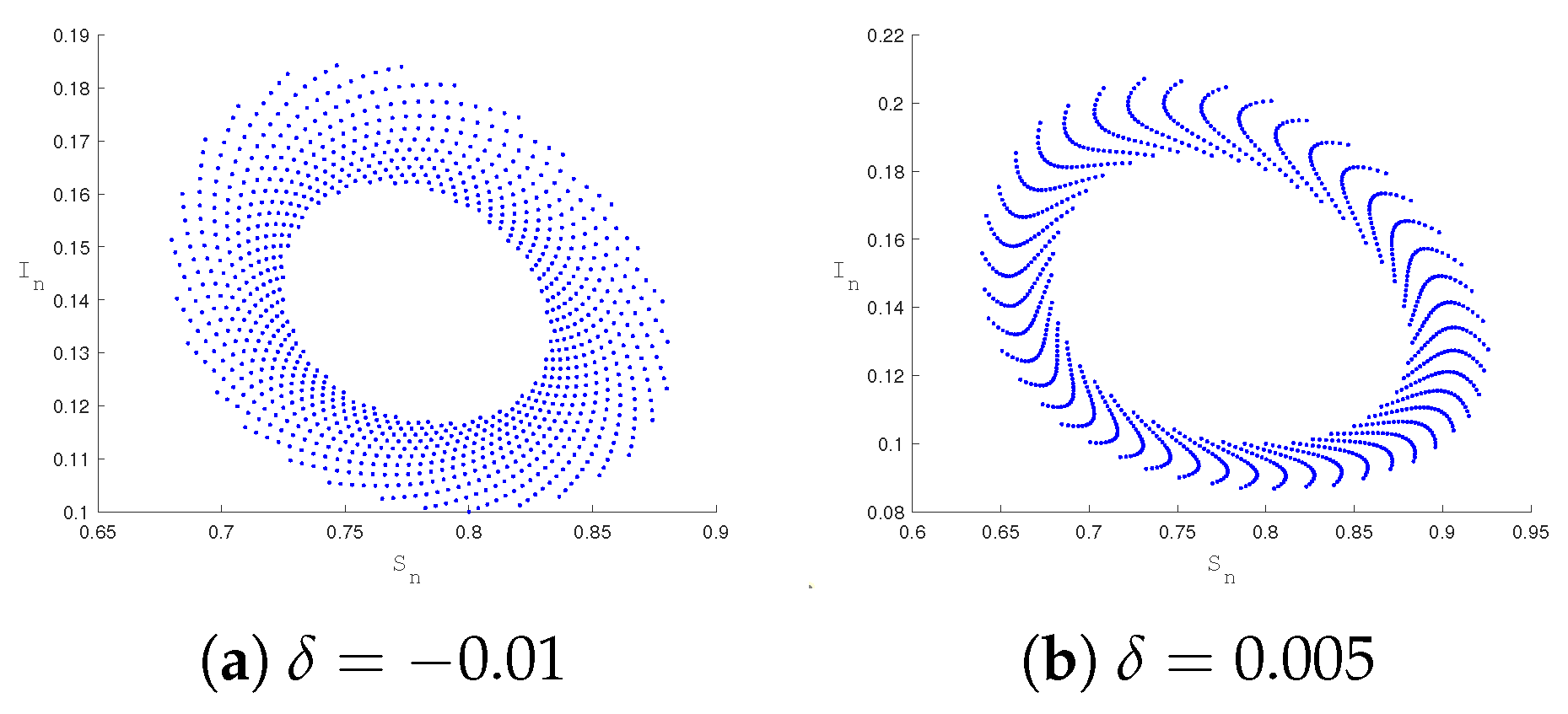

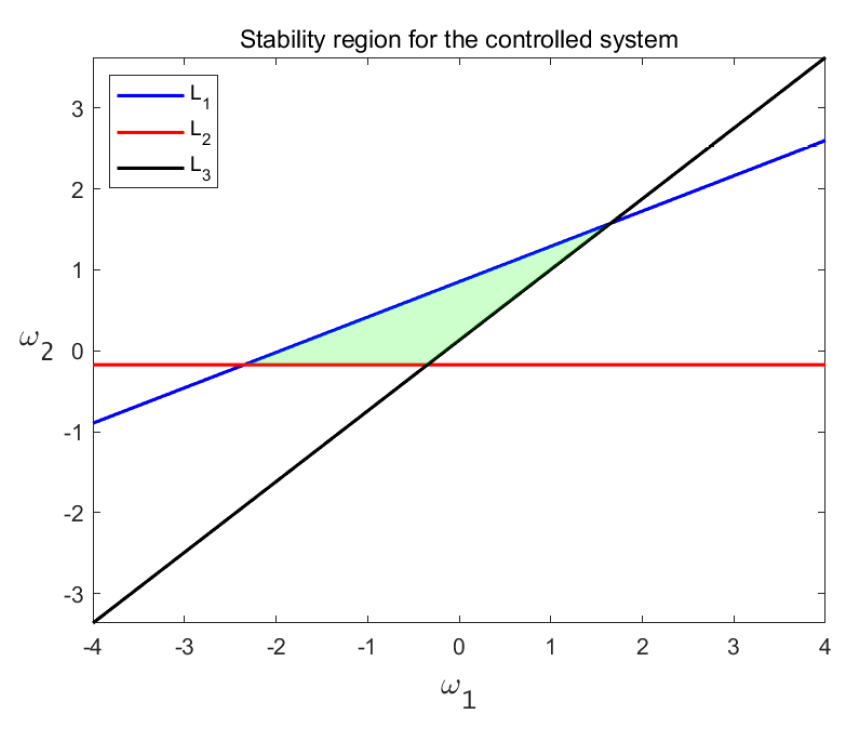

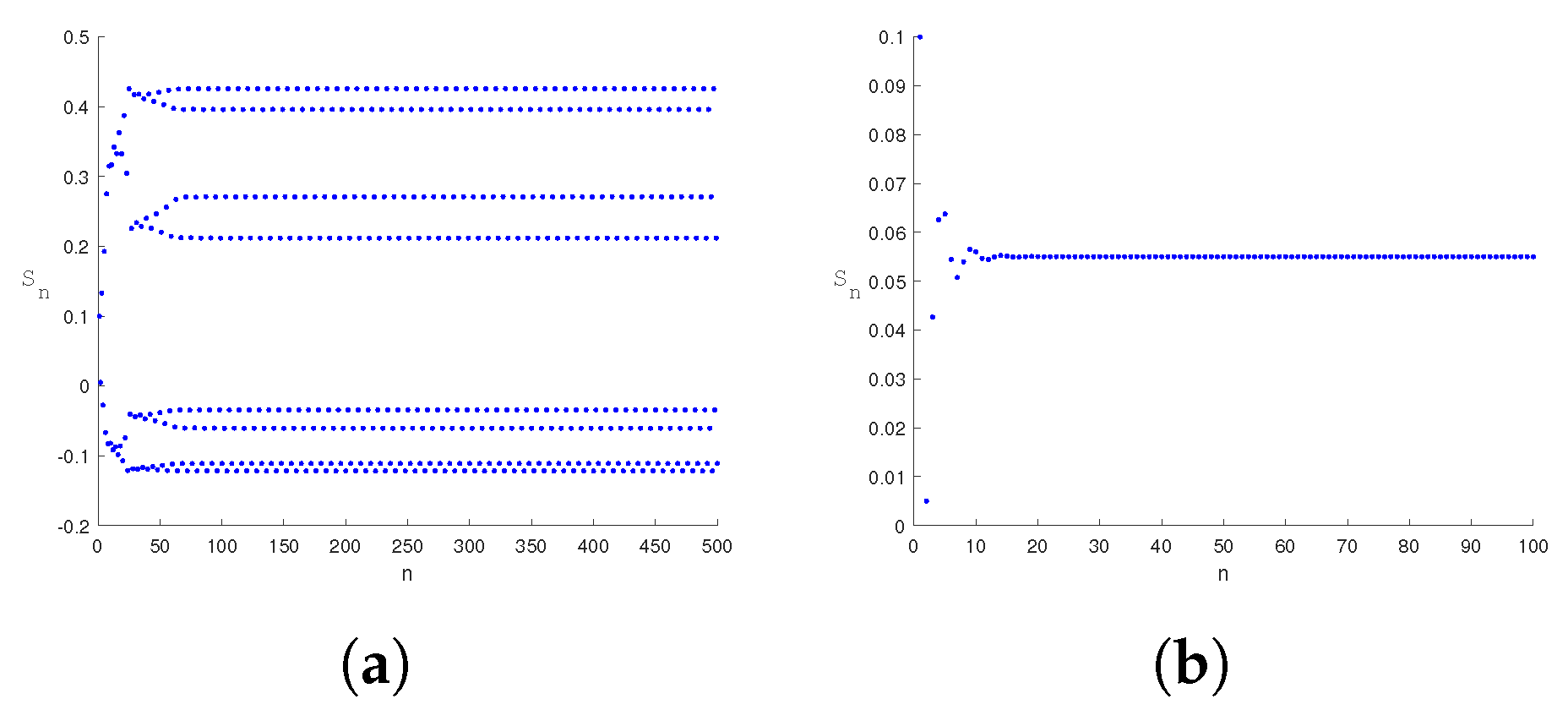
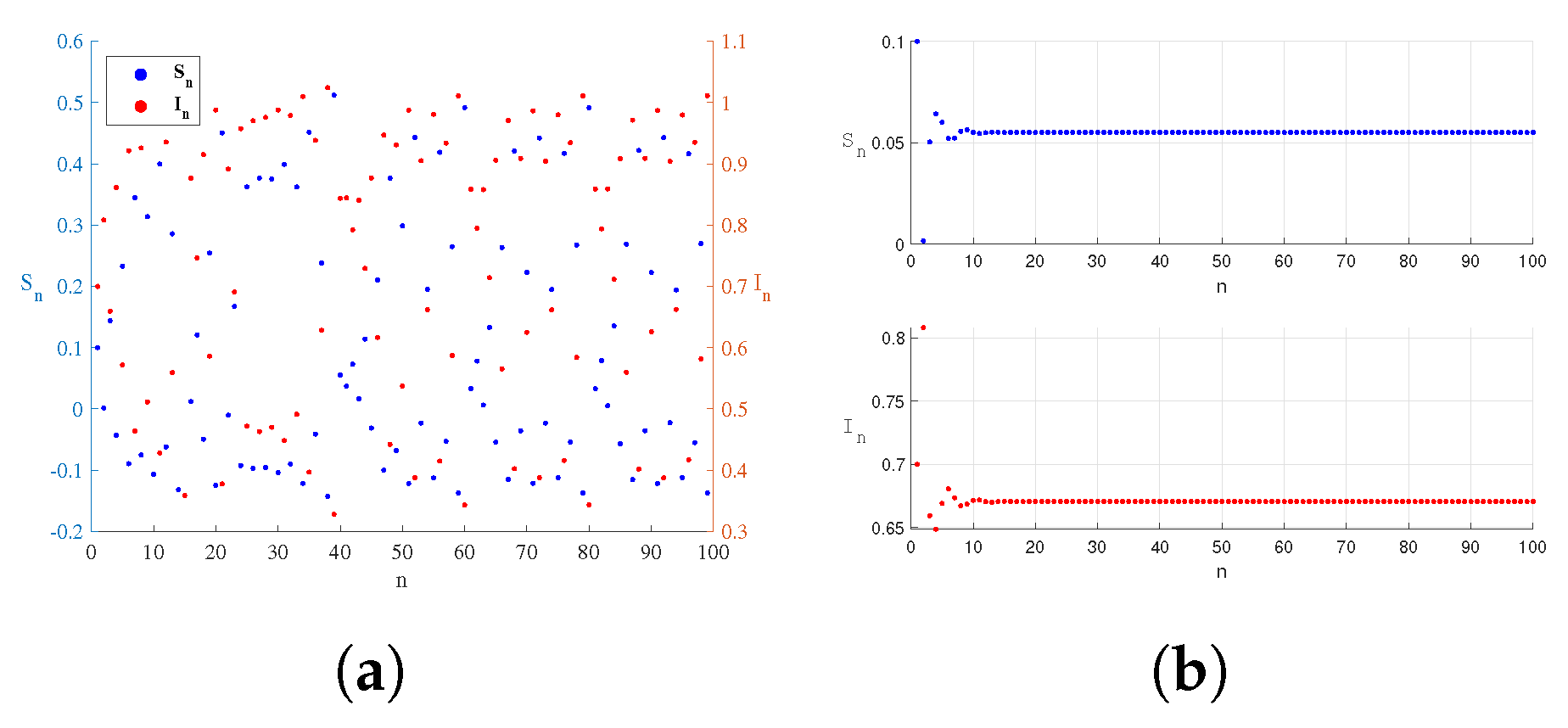

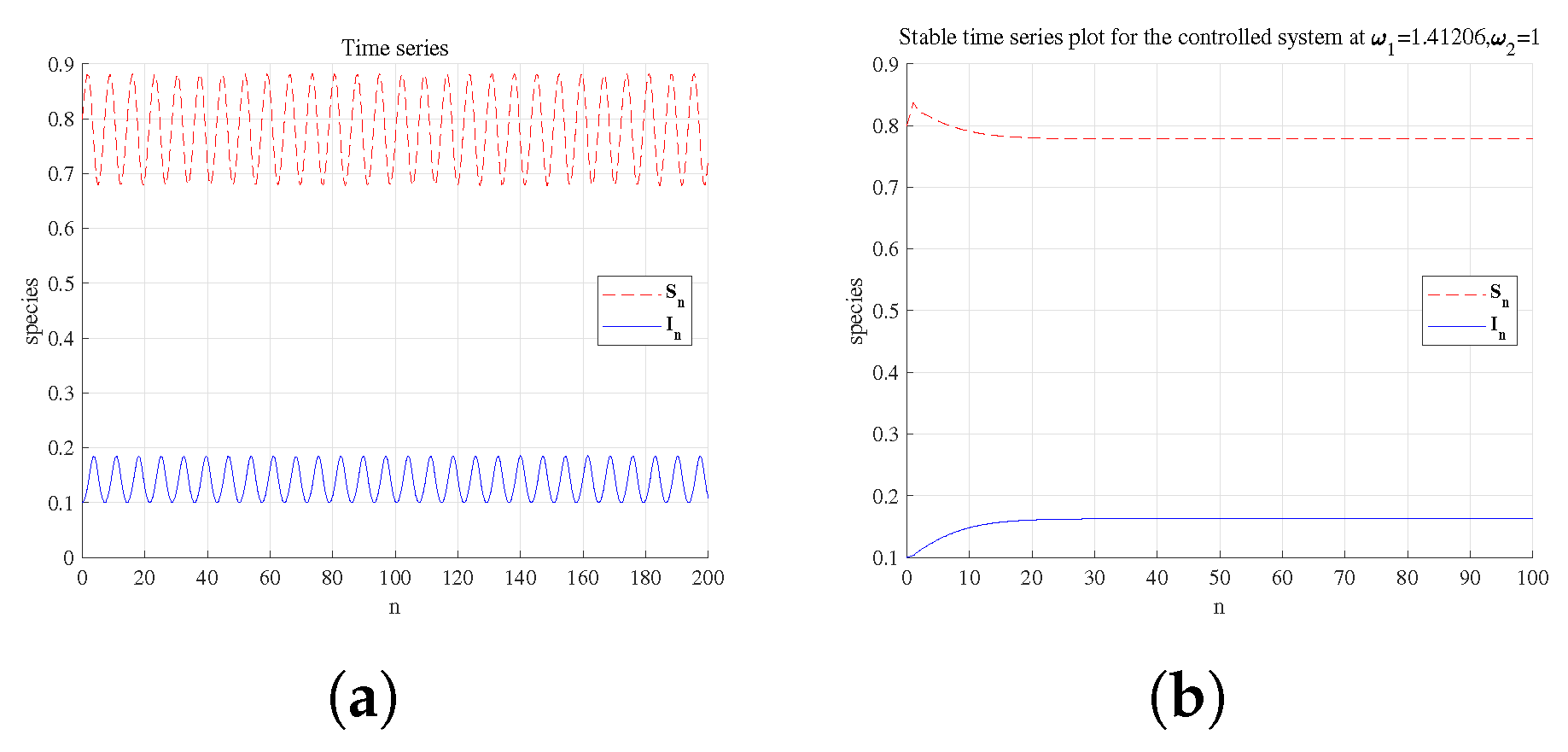
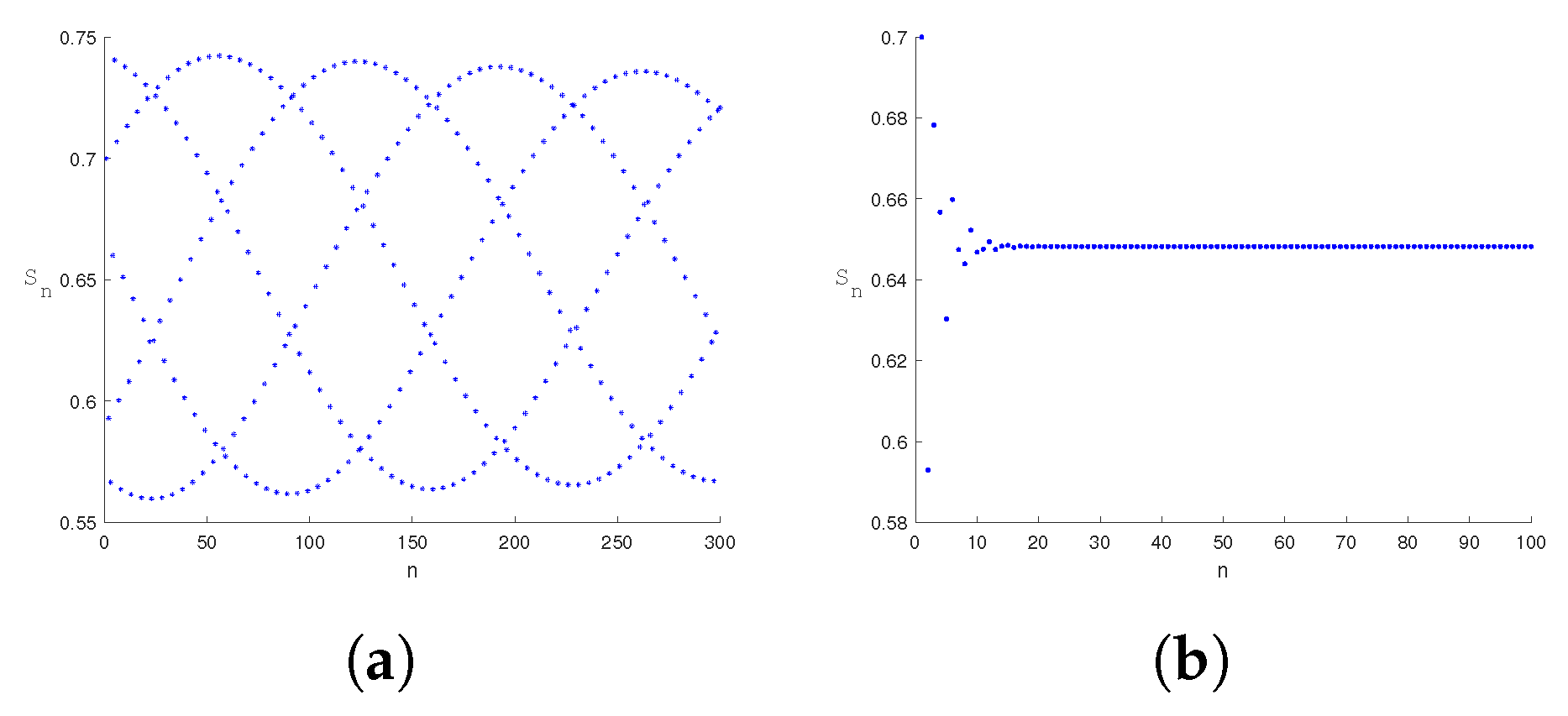
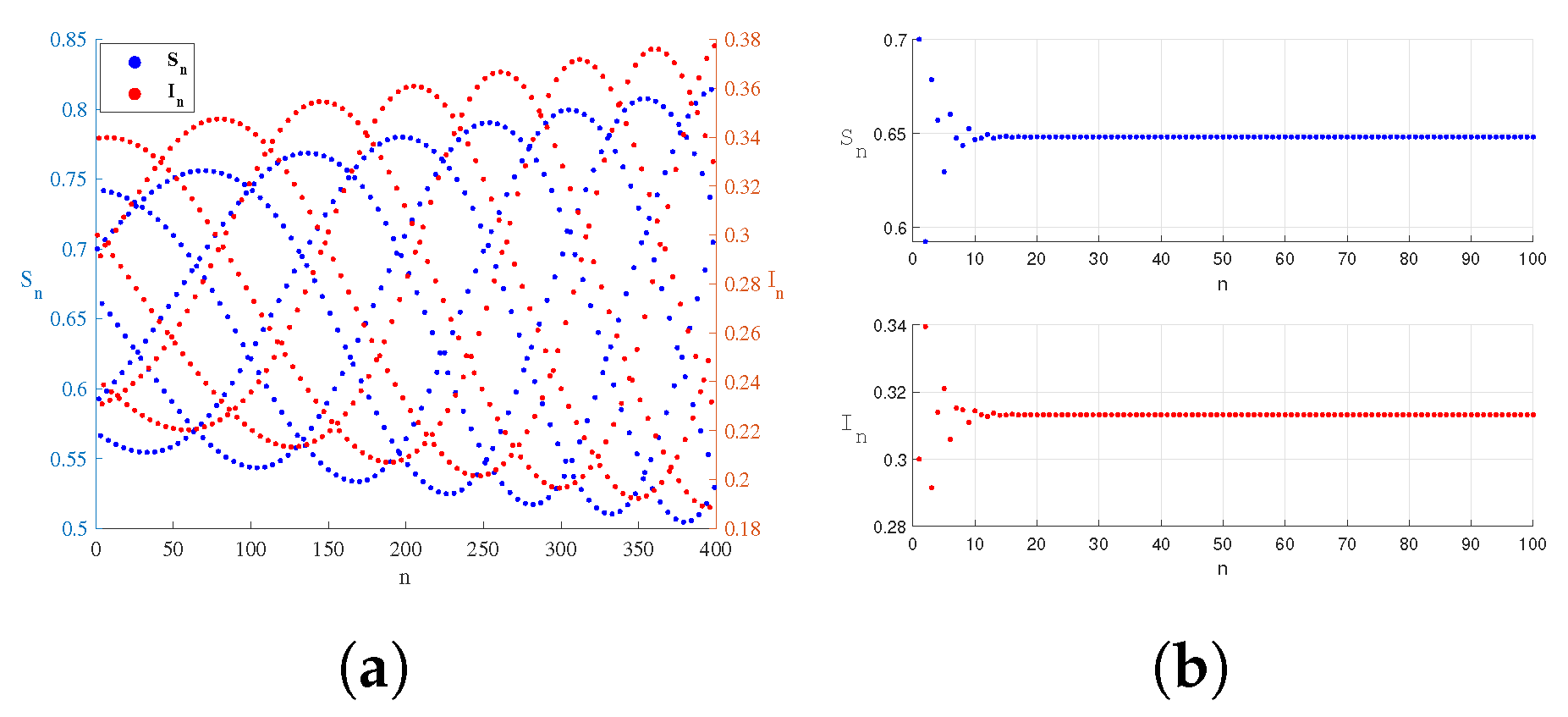
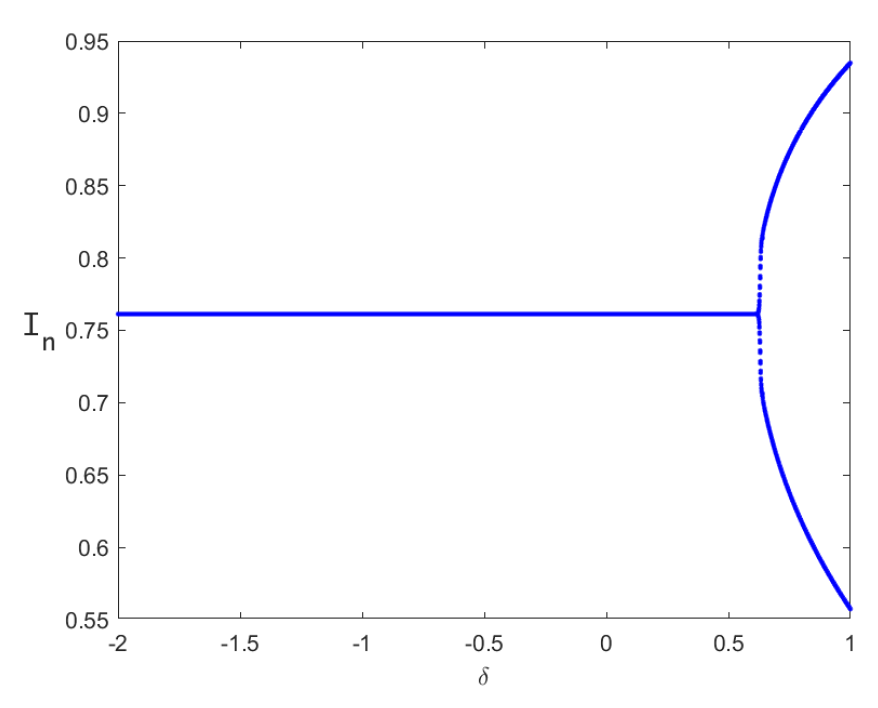
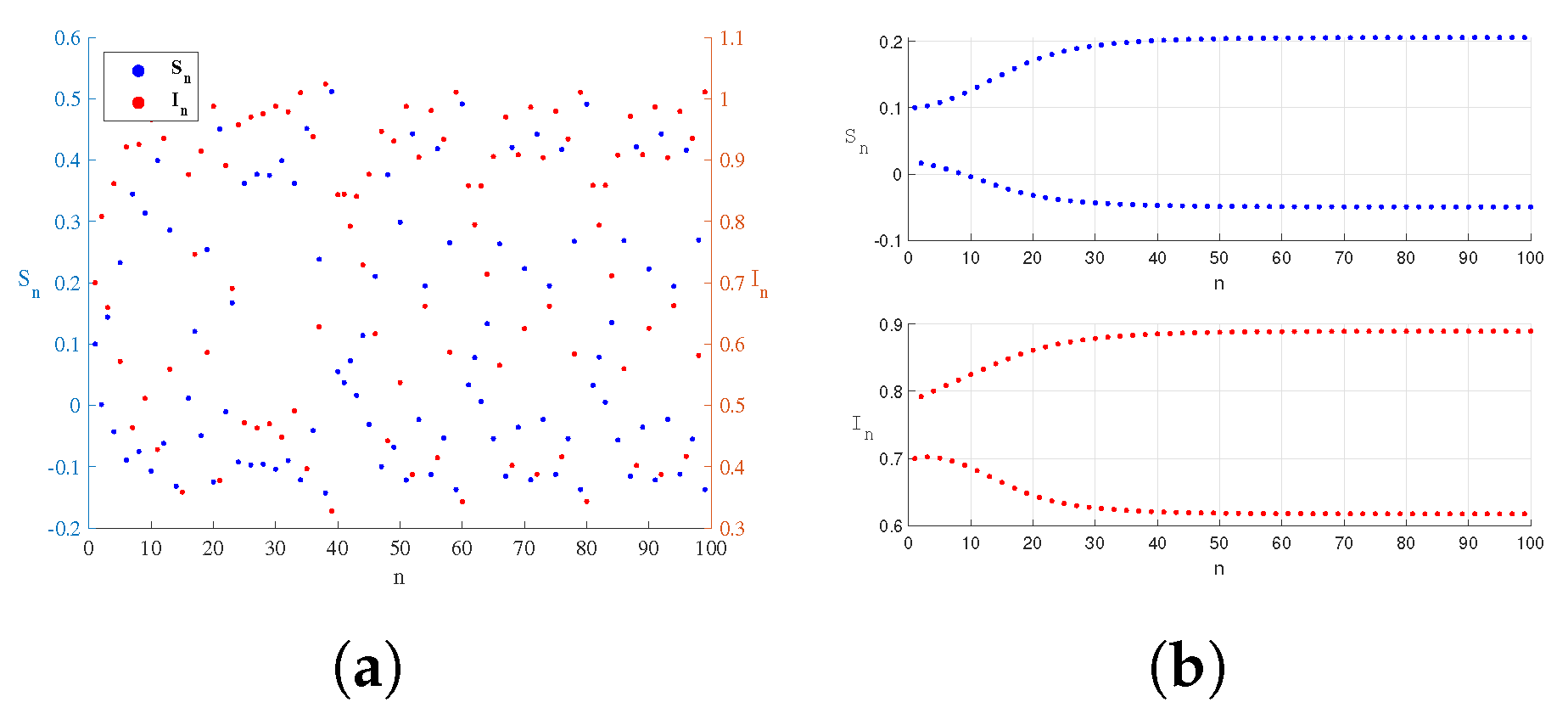
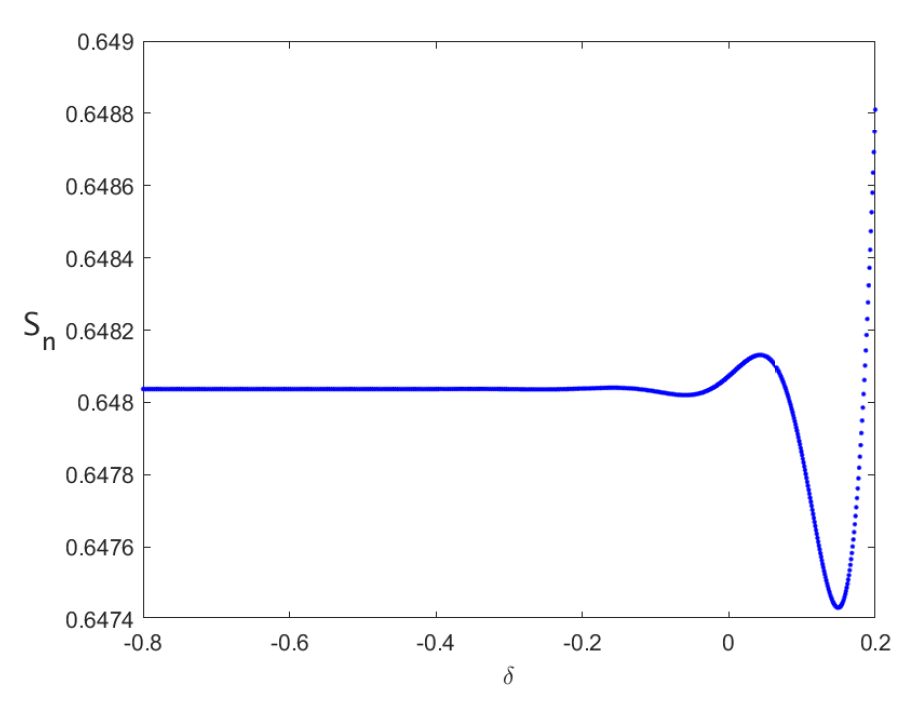
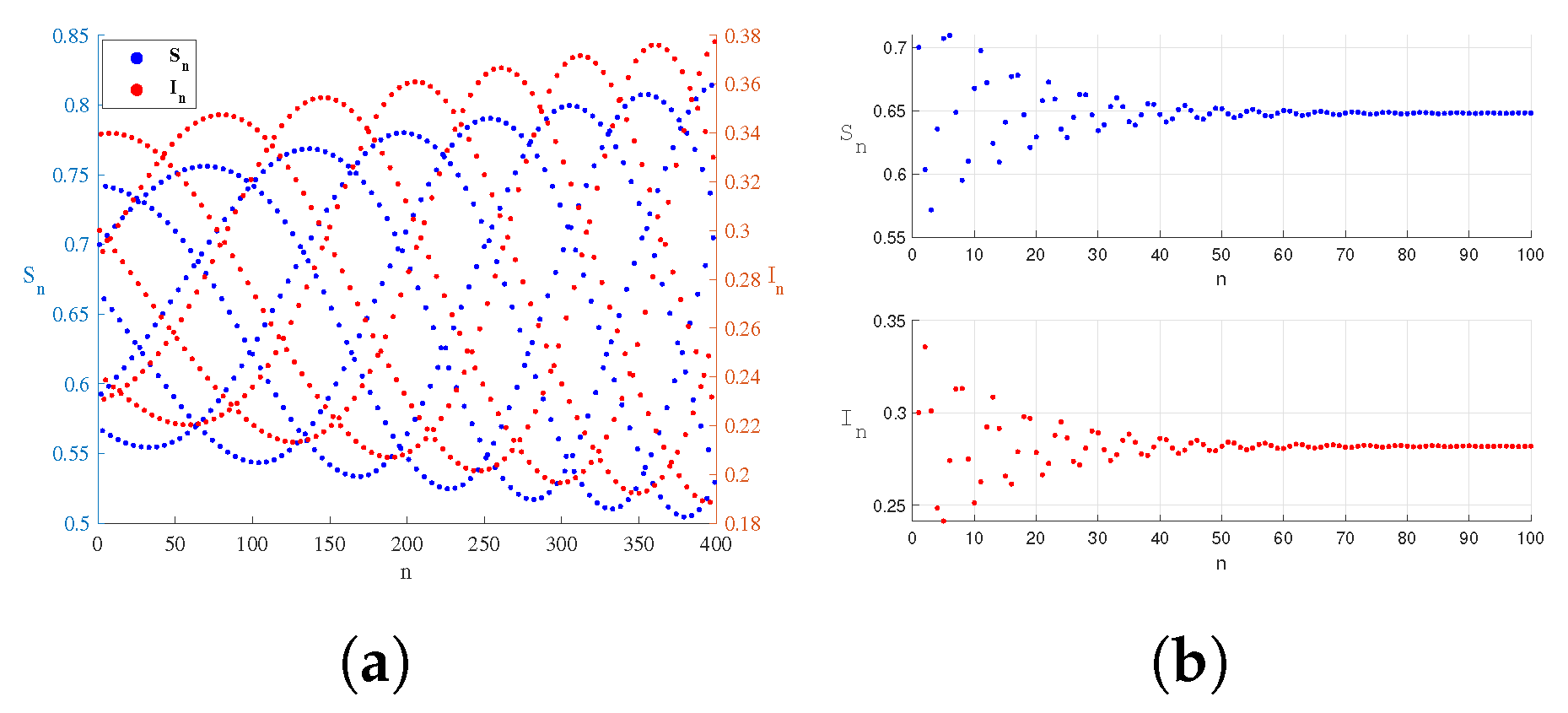
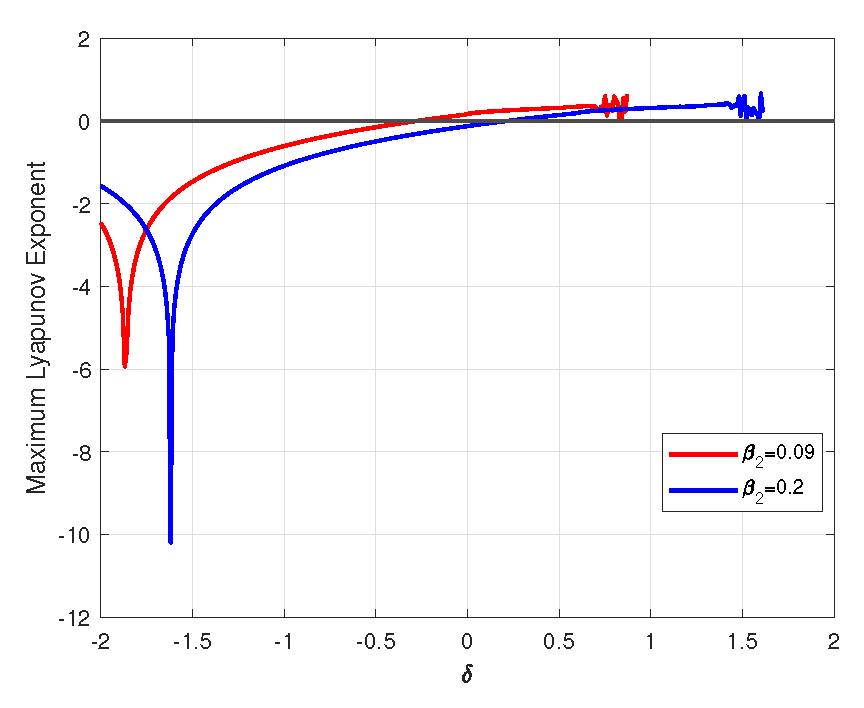
Disclaimer/Publisher’s Note: The statements, opinions and data contained in all publications are solely those of the individual author(s) and contributor(s) and not of MDPI and/or the editor(s). MDPI and/or the editor(s) disclaim responsibility for any injury to people or property resulting from any ideas, methods, instructions or products referred to in the content. |
© 2025 by the authors. Licensee MDPI, Basel, Switzerland. This article is an open access article distributed under the terms and conditions of the Creative Commons Attribution (CC BY) license (https://creativecommons.org/licenses/by/4.0/).
Share and Cite
Liang, Y.; Wang, W. Analysis of the Dynamic Properties of a Discrete Epidemic Model Affected by Media Coverage. Axioms 2025, 14, 681. https://doi.org/10.3390/axioms14090681
Liang Y, Wang W. Analysis of the Dynamic Properties of a Discrete Epidemic Model Affected by Media Coverage. Axioms. 2025; 14(9):681. https://doi.org/10.3390/axioms14090681
Chicago/Turabian StyleLiang, Yanfang, and Wenlong Wang. 2025. "Analysis of the Dynamic Properties of a Discrete Epidemic Model Affected by Media Coverage" Axioms 14, no. 9: 681. https://doi.org/10.3390/axioms14090681
APA StyleLiang, Y., & Wang, W. (2025). Analysis of the Dynamic Properties of a Discrete Epidemic Model Affected by Media Coverage. Axioms, 14(9), 681. https://doi.org/10.3390/axioms14090681




